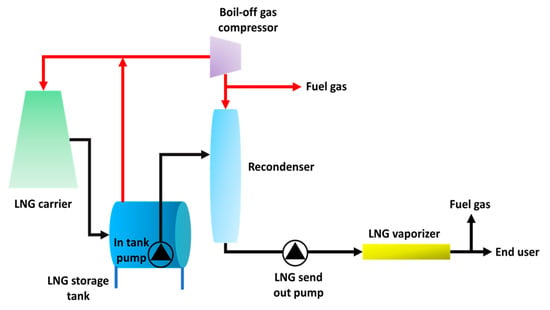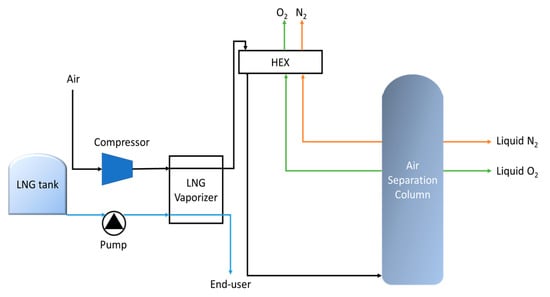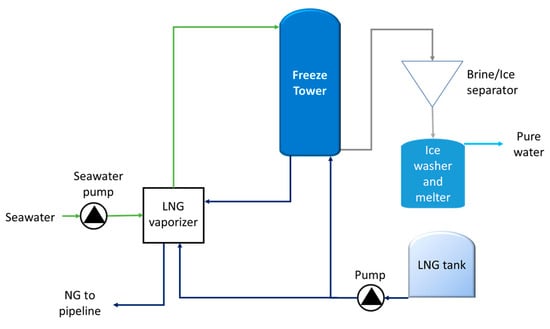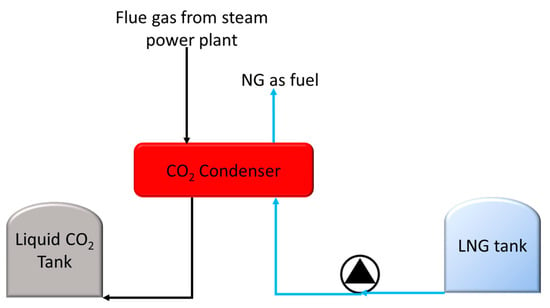While LNG is a clean and efficient energy source, the cold energy produced during the regasification process is often released into the environment through vaporizers and warmed by external substances. Furthermore, releasing cold energy into the surrounding environment can be problematic because it may harm aquatic life and the wasted energy could have been used to power other systems or processes instead
[16][21]. This wasted energy can contribute to inefficiencies
[17][22] in the overall energy system and increase the environmental impact of the LNG supply chain. By capturing and making use of the cold energy, it is possible to enhance the energy efficiency of LNG regasification terminals and the economic viability of the LNG supply chain. Additionally, utilizing cold energy can help to reduce greenhouse gas emissions
[18][23] and contribute to a more sustainable energy system
[19][24]. There have been many studies that reported applying this cold energy from the LNG regasification process
[16][21].
2. Trends of Current LNG Cold Energy Utilization
The cold energy in LNG holds unique properties that make it useful in various applications, especially in the oil and gas industry
[20][26]. Cold energy is a valuable resource that is produced during the regasification of LNG. The process of vaporizing LNG in vaporizers generates a large amount of cold energy, which can be used in a variety of applications, such as power generation, air separation, desalination, CO
2 capture, data center cooling, and cold storage
[16][21]. However, it is important to consider the distribution pressure of natural gas when utilizing LNG cold energy, as the required pressure values can vary depending on the intended use of the gas. Additionally, while the amount of LNG cold energy produced is generally higher in larger systems, it is more beneficial to consider LNG cold exergy when designing cold utilization systems due to the inclusion of destruction and loss terms in the exergy concept
[21][27].
2.1. Power Generation
The trade of LNG has seen a rapid growth in the past two decades
[22][28]; however, with global warming on the rise, there is an increased need for sustainable solutions. Environmental policies are also becoming stricter, making it imperative to find ways to reduce greenhouse gas emissions. LNG cryogenic technology presents a solution to this problem, as it allows for the capture and utilization of the cold energy stored in LNG. This can be achieved by using cold energy to vaporize a working fluid, such as R-141b, which then expands through a turbine to generate electricity. This process can significantly increase the efficiency of the power generation process and reduce the overall costs, making it a promising opportunity for sustainable and cost-effective power generation. This not only increases the energy efficiency of LNG regasification terminals but also the economic benefit of the LNG supply chain. It can also be used for power generation
[23][29], further reducing the dependence on fossil fuels and contributing to the reduction in greenhouse gas emissions.
2.2. Air Separation
A distillation column is used in the cryogenic air separation process to lower the temperature of the air to the cryogenic temperature (below −195 °C at atmospheric pressure) and then separates the air into its component gases, such as oxygen and nitrogen. Because the procedure takes place at such a subzero temperature, the refrigeration cycle requires a substantial amount of power in order to function properly. Therefore, the exploitation of LNG cold energy in the air separation process can decrease the amount of energy that is consumed while concurrently reconverting LNG to NG.
Figure 2 illustrates the air separation process that makes use of the cold energy provided by LNG. By taking the place of the traditional refrigeration cycle, LNG is now employed to bring the temperature of the air down.
Figure 2. Air separation with LNG cold energy utilization [24]. Air separation with LNG cold energy utilization [39].
A study by Kim and coworkers
[25][70] looked into incorporating an air separation unit (ASU) with LNG vaporization at import terminals as a method for utilizing the cold energy from LNG. Two different options for integration were proposed by the researchers, and the performance was evaluated based on the energy and exergy analyses. The findings indicate that utilizing an LNG stream for precooling results in a decrease in specific power consumption and a higher exergy efficiency in comparison to the alternative, which utilizes a liquid nitrogen production cycle. This suggests that the integration of an ASU with LNG vaporization can be a useful way to utilize LNG cold energy and improve energy efficiency. In 2019, a study by Chen and colleagues proposed the use of a vapor recompression column (VRC) in an air ASU that utilizes the cryogenic energy of LNG
[26][71]. The study compared the thermodynamic characteristics of three different types of cryogenic rectification columns for air separation using the first and second laws of thermodynamics. The outcome of the study revealed that the VRC (variable reflux column) was the most appropriate column for the ASU when utilizing LNG cold energy, as it had the lowest energy demand for shaft work and the lowest energy consumption during the separation process. Furthermore, it was found that by utilizing cryogenic energy from the product to cool the reflux and feed air, the efficiency can be increased. The proposed process had the potential to produce liquid oxygen and had a lower power consumption of 6.9% and 11.1% in comparison to earlier studies
[27][72] when producing both vapor and liquid product. The use of LNG cryogenic energy also resulted in an improvement in the minimum energy of separation.
A study by Wu et al.
[28][73] proposed a new method for producing high-purity oxygen through a cryogenic air separation process that utilizes the cold energy released during LNG regasification. The proposed system employed strategies such as utilizing waste N
2 fully, cascading heat transfer, and multi-column air distillation to reduce power consumption. The results of the thermodynamic analysis show that the specific power consumption of liquid oxygen and liquid nitrogen are 0.252 kWh/kg and 0.258 kWh/kg, respectively, and the overall exergy efficiency and LNG cold exergy utilization efficiency are 0.7165 and 0.5318, respectively. The study also includes an analysis of the sensitivity of the system to changes in the outlet temperature of sub-coolers and the number of stages in the low-pressure column in order to assess their impact on the total power consumption and equipment investment. Overall, the proposed process has the potential to be cost-effective for producing high-purity oxygen in the industrial field. Han et al.
[29][74] proposed various design options and evaluated them to combine LNG regasification and air separation, as a way to harness the low-grade cold energy of LNG and decrease power consumption. Four external circulation designs were compared, using energy and exergy thermodynamic models, to traditional and existing systems using the Linde cycle with LNG precooling. The results show that these proposed schemes were able to greatly decrease the energy consumption per unit of liquid product, with the most efficient design consuming 0.189 kW·h·kg
−1. According to the study, the external circulation scheme utilizing high-pressure LNG and low-pressure circulating nitrogen was found to be the most efficient option. It had the smallest demand for LNG, the least exergy loss, and the highest exergy efficiency of 0.869, as well as the best utilization rate of LNG cold energy.
He et al.
[30][75] proposed an air separation unit with energy storage and air recovery (ASU-ESAR) that was designed to fully recycle the high-purity air produced during energy release from LAES technology, as well as energy in the form of low temperature and high pressure. The ASU-ESAR was expected to improve the energy conservation efficiency and economic benefits of air separation processes, and potentially reduce the peak-valley ratio of China’s power grid and CO
2 emissions by 13% and 12.53–27.71 Mt per year, respectively. The payback period for an LAES system with a power capacity of 70.70–74.38 MWh/day is estimated to be 2.2–2.9 years.
In 2022, Hamayun et al.
[31][76] proposed a new process for the production of high-purity nitrogen by harnessing the cold energy from LNG regasification. Results show that the integrated process between ASU and cold energy from LNG regasification was more efficient in terms of power consumption and exergy destruction compared to the standalone process. An advanced exergy analysis also revealed that 44.3% of the total exergy destruction in the process was preventable, and 91.7% of this destruction was of endogenous nature, suggesting that improving the efficiency of individual pieces of equipment should be the top priority for process improvement. This study highlights the potential for integrating LNG regasification with air separation as a way to recover cold energy and improve the efficiency of nitrogen production.
Other recent studies that consider cold energy from LNG regasification for air separation process are tabulated in
Table 1.
Table 1.
Other works on standalone and integrated ASU systems.
Using LNG as a source of cold energy, Ong et al.
[45][90] assessed the technical and economic feasibility of a direct-contact type of seawater freezing desalination (SFD) process, in which cold energy from the regasification of LNG is used to generate freshwater ice from seawater. The researchers carried out process analysis, integration, and optimization using detailed material and energy balance models. They also looked at the influence of various operating variables on the efficiency of the process, such as inlet temperatures and flow rates. The study found that the optimized process was able to produce 1.64 kg/s of freshwater using 7.83 kg/s of seawater, while consuming 1.66 kW of electric power. The researchers also examined the effect of electricity and water prices on the cost and income of the process in different regions. Overall, the results suggest that the SFD process using LNG regasification cold energy as a technically and economically feasible option for seawater desalination. Ghorbani et al.
[46][91] presented a report on an integrated system that generates electricity and fresh water simultaneously by utilizing a multi-stage thermal water desalination system and an ORC. The system utilizes parabolic trough solar collectors and the regasification of LNG to provide input heat and condenser cooling for the ORC, respectively. The system, which was simulated based on climatic data from Tehran and Iran, can produce 3628 kgmol/h of fresh water and 459.9 MW of electricity, with an ORC efficiency of 12.47% and a gain output ratio of 2.918 for the multi-effect desalination system. An exergy analysis revealed that the total exergy efficiency of the system is 87.11%, with heat exchangers and collectors contributing the largest shares of exergy destruction at 50.23% and 38.18%, respectively.
Lee et al.
[47][92] proposed a dual-expander organic Rankine cycle hydrate-based desalination (ORC-HBD) process as a hybrid desalination system that uses LNG cold energy to generate electricity and pure water. The process consists of two expanders and a reverse osmosis system and can be optimized for use with various liquid-phase and gas-phase hydrate formers, including propane, R125A, R141B, and cyclopentane. The process was found to be highly energy and exergy efficient, with a negative product cost and profit of up to 3.095 USD/ton of pure water when using free external heat. Based on the research conducted, it holds significant potential as a solution for addressing water shortages and energy crises. Recently, Salakhi et al.
[48][93] examined the feasibility of using the cold energy from LNG to desalinate seawater through FD. By directly utilizing the cold energy of LNG in an appropriate temperature range, the process eliminates the need for a secondary refrigerant and its refrigeration cycle. The optimization aimed to find the optimal conditions for maximizing ice production while minimizing the salt content in the resulting ice. The results indicate that as the LNG inlet temperature decreased from −10 to −60 °C, the ice mass production increased from 60.9 to 977.6 g, but also decreased the quality by 90%. Increasing the Reynolds number of LNG from 4000 to 32,000 also increased the ice production by 492 g, but also increased the ice salinity from 1.22 to 1.56%. It was also found that potable water could be produced through three-stage desalination with Reynolds numbers below 16,000. These findings suggest that the use of LNG cold energy has the potential to be a sustainable solution for desalination. Several other similar works on integrating seawater desalination with cold energy from LNG regasification are as tabulated in
Table 2.
Table 2.
Other works on desalination system using cold energy from LNG regasification.
2.3. Desalination of Seawater
Desalination is a process that involves the removal of mineral components found in seawater through the use of a significant amount of energy
[38][83]. Because both the desalination facility and the regasification terminal of LNG are situated near the shore, it is possible to make use of the LNG cold energy during the desalination process, which in turn will lower the amount of energy that is required
[39][84]. The desalination process can be achieved through two common methods, reverse osmosis (RO)
[40][85] and multi-stage flash distillation (MSF)
[41][86], each with their own advantages and disadvantages. In addition to these two methods, there is a third technique known as freeze desalination (FD)
[42][87], which involves the creation of ice crystals that are resistant to the effects of salt. This method is used to remove minerals from saltwater. Because the latent heat of ice formation (335 kJ/kg) is approximately seven times lower than the heat of vaporization (2260 kJ/kg), FD is more effective in terms of the utilization of energy when compared to the thermal desalination processes
[43][88].
Figure 3 presents the FD process, which makes use of the cold energy provided by LNG based on work carried out by
[44][89]. As shown in
Figure 35, LNG cold energy can be used to precool saltwater and provide a low-temperature working environment for the freeze tower.
Figure 3. Diagram of FD process utilizing LNG cold energy [16]. Diagram of FD process utilizing LNG cold energy [
It is clear from the studies reviewed that the use of cold energy from LNG in desalination processes has the potential to be a sustainable and cost-effective solution to the increasing demand for fresh water. By utilizing the cold energy from LNG in processes such as FD, it is possible to produce high-purity water with low energy consumption. However, further research is needed to optimize and commercialize these technologies in order to make them a viable option for large-scale desalination.
2.4. CO
2
Capture Using Cryogenic Process
Liquification is the first step in the cryogenic CO
2 capture process, which is a method for extracting CO
2 from exhaust gas
[54][99]. The standard cryogenic CO
2 capture method calls for an external refrigeration cycle to be used in order to chill and liquefy CO
2, which necessitates a large power consumption
[55][100]. Using NG or LNG as a fuel source for power plants, by merging the regasification process of LNG with cryogenic CO
2 capture, could lead to substantial energy savings while simultaneously reducing the plant’s carbon footprint
[56][101].
Figure 4 depicts a cryogenic method for the extraction of CO
2 that also makes use of the cold energy that LNG provides. In order to obtain liquid CO
2, LNG is used to cool the flue gas that is emitted from the boiler to a temperature that is lower than the temperature at which CO
2 will condense in the condenser. The regasified NG is then introduced as combustion fuel into the boiler at this point.
Figure 4.
Cryogenic CO
2 capture using LNG cold energy [16]. capture using LNG cold energy [21].
A cryogenic CO
2 capture system for small-scale power generation systems was proposed by Kanbur et al. in 2018
[57][102]. The system captures liquid CO
2 during the regasification process of LNG and produces byproducts such as condensed water and a mixture of nitrogen and oxygen. The proposed system was simulated for microturbines with capacities of 30, 65, and 200 kW. The results of thermodynamic, environmental, and enviroeconomic evaluations show that the system is feasible for the 30 and 65 kW models, with low power decrement rates of 1.81% and 3.15%, respectively. The 200 kW model was found to be infeasible due to higher power decrement rates. The proposed system was also evaluated in a case study for Singapore, showing annual money savings through the capture of liquid CO
2 and production of water. Later in 2019, Wang et al.
[58][103] proposed a system for utilizing the cryogenic exergy of LNG in a cascade nested ORC. The system captures CO
2 from flue gas while also producing power and utilizing LNG as a heat sink. The performance of the system was evaluated based on exergy efficiency, cold energy utilization efficiency, power generation, and CO
2 capture. The research found that the utilization of an appropriate mixed working fluid and the inclusion of a regenerator can greatly improve the system’s performance, but also discovered that increasing the LNG regasification pressure leads to higher exergy efficiency and cold energy utilization efficiency, but also a decrease in CO
2 capture quantity and power generation.
Ghorbani et al.
[59][104] developed a novel approach for simultaneous power generation, cooling, and production of fresh water using solar energy and heat loss. The approach involves the use of a hybrid system consisting of an ORC, a refrigeration cycle using a mixture of ammonia and water to produce LNG and liquid CO
2, a CO
2 capture process, and a multiple-effect distillation desalination system. The system has the capacity to produce 14.5 tons/h of LNG, 1.693 tons/h of desalinated water, and 2.611 tons/h of liquid CO
2. The exergy analysis showed that the overall exergy efficiency of the process was 88.97%, with the highest exergy destruction occurring in the towers and the lowest in valves and drums. The economic analysis of the hybrid system determined that the investment would be recouped within 6 years and the cost of the product would be 24.2 cents/kg LNG. A sensitivity analysis was also conducted to identify the key parameters that impact the performance of the developed hybrid system.
Kim et al.
[60][105] recently presented a new method for capturing and storing CO
2 using the cold energy from LNG in a NG combined cycle (NGCC) power plant. The proposed process is a cryogenic solid-phase method that uses LNG cold energy to reduce the energy-intensive thermal treatment of the monoethanolamine-based absorption process and the power consumption needed to compress CO
2 to 150 bar. The process also requires minimal equipment installation in the NGCC power plant by integrating the LNG cold energy utilization and CO
2 capture processes. The proposed method reduces the efficiency penalty of the NGCC power plant from 14.34% to 3.51% and has a 99.93% CO
2 capture rate. The study offers a potential solution for reducing the efficiency penalty of cryogenic CO
2 capture and storage (CCS) processes and overcoming the challenges of conventional methods. Several other similar works on integrating CO
2 capture with cold energy from LNG regasification are as tabulated in
Table 3.
Table 3.
Other works on CO
2
capture system using cold energy from LNG regasification.
In summary, using LNG cold energy for CO
2 capture has the potential to effectively reduce the energy consumption and efficiency penalty associated with traditional CO
2 capture processes. By integrating LNG cold energy utilization and CO
2 capture processes, the equipment installation requirements for CO
2 capture can be minimized. The cryogenic solid-phase CCS process using LNG cold energy has been shown to be effective in reducing the efficiency penalty in NG combined cycle power plants, with a 99.93% CO
2 capture rate and a reduction in the efficiency penalty from 14.34% to 3.51%. This approach can provide a promising solution for mitigating CO
2 emissions while also utilizing a readily available energy source.




